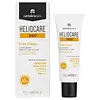What's inside
What's inside
 Key Ingredients
Key Ingredients

 Benefits
Benefits

 Concerns
Concerns

 Ingredients Side-by-side
Ingredients Side-by-side

Water
Skin ConditioningZinc Oxide
Cosmetic ColorantC12-15 Alkyl Benzoate
AntimicrobialIsostearic Acid
CleansingPolyhydroxystearic Acid
EmulsifyingCyclopentasiloxane
EmollientPEG/PPG-18/18 Dimethicone
EmulsifyingIsododecane
EmollientGlycerin
HumectantNiacinamide
SmoothingSilica
AbrasiveDimethicone/Vinyl Dimethicone Crosspolymer
Skin ConditioningCaprylyl Methicone
Skin ConditioningPEG-12 Dimethicone/PPG-20 Crosspolymer
Titanium Dioxide
Cosmetic ColorantCetyl PEG/PPG-10/1 Dimethicone
EmulsifyingTalc
AbrasiveSodium Chloride
MaskingSalix Alba Bark Extract
AstringentMelia Azadirachta Leaf Extract
Skin ConditioningMelaleuca Alternifolia Leaf Extract
PerfumingScutellaria Baicalensis Callus Culture
Skin ConditioningCentella Asiatica Extract
CleansingBisabolol
MaskingHamamelis Virginiana Extract
AntiseborrhoeicGlycine Soja Seed Extract
Skin ConditioningHouttuynia Cordata Extract
Skin ConditioningScutellaria Baicalensis Root Extract
AstringentRehmannia Chinensis Root Extract
Skin ConditioningPhellodendron Amurense Bark Extract
Skin ConditioningLactobacillus/Pear Juice Ferment Filtrate
Skin ConditioningButylene Glycol
HumectantGlycolic Acid
BufferingPEG-60 Hydrogenated Castor Oil
EmulsifyingEthylhexylglycerin
Skin ConditioningGlyceryl Caprylate
EmollientO-Cymen-5-Ol
AntimicrobialPEG-10 Dimethicone
Skin ConditioningMagnesium Sulfate
Phenoxyethanol
PreservativeWater, Zinc Oxide, C12-15 Alkyl Benzoate, Isostearic Acid, Polyhydroxystearic Acid, Cyclopentasiloxane, PEG/PPG-18/18 Dimethicone, Isododecane, Glycerin, Niacinamide, Silica, Dimethicone/Vinyl Dimethicone Crosspolymer, Caprylyl Methicone, PEG-12 Dimethicone/PPG-20 Crosspolymer, Titanium Dioxide, Cetyl PEG/PPG-10/1 Dimethicone, Talc, Sodium Chloride, Salix Alba Bark Extract, Melia Azadirachta Leaf Extract, Melaleuca Alternifolia Leaf Extract, Scutellaria Baicalensis Callus Culture, Centella Asiatica Extract, Bisabolol, Hamamelis Virginiana Extract, Glycine Soja Seed Extract, Houttuynia Cordata Extract, Scutellaria Baicalensis Root Extract, Rehmannia Chinensis Root Extract, Phellodendron Amurense Bark Extract, Lactobacillus/Pear Juice Ferment Filtrate, Butylene Glycol, Glycolic Acid, PEG-60 Hydrogenated Castor Oil, Ethylhexylglycerin, Glyceryl Caprylate, O-Cymen-5-Ol, PEG-10 Dimethicone, Magnesium Sulfate, Phenoxyethanol
Water
Skin ConditioningOctocrylene
UV AbsorberEthylhexyl Salicylate
UV AbsorberButyl Methoxydibenzoylmethane
UV AbsorberButylene Glycol
HumectantPhenylbenzimidazole Sulfonic Acid
UV AbsorberArginine
MaskingDimethicone
EmollientDiethylamino Hydroxybenzoyl Hexyl Benzoate
UV FilterPhenethyl Benzoate
EmollientSilica
AbrasiveTris-Biphenyl Triazine
UV AbsorberPolymethylsilsesquioxane
Styrene/Acrylates Copolymer
Polypodium Leucotomos Leaf Extract
Skin ProtectingEthylhexyl Triazone
UV AbsorberPhysalis Angulata Extract
Skin ProtectingPlankton Extract
Skin ConditioningMelanin
Skin ProtectingOxothiazolidine
Skin ProtectingSodium Hyaluronate
HumectantGlycerin
HumectantTrehalose
HumectantUrea
BufferingSerine
MaskingPullulan
Algin
MaskingC20-22 Alkyl Phosphate
EmulsifyingPhenylpropanol
MaskingC20-22 Alcohols
Emulsion StabilisingVp/Acrylates/Lauryl Methacrylate Copolymer
Sodium Acrylates Crosspolymer-2
AbsorbentAcrylates/C10-30 Alkyl Acrylate Crosspolymer
Emulsion StabilisingPropylene Glycol
HumectantCaprylyl Glycol
EmollientPropanediol
SolventPentylene Glycol
Skin ConditioningMethicone
EmollientCaprylic/Capric Triglyceride
MaskingDisodium Phosphate
BufferingGlyceryl Polyacrylate
Disodium EDTA
Tocopheryl Acetate
AntioxidantPotassium Phosphate
BufferingLecithin
EmollientBHT
AntioxidantSodium Benzoate
MaskingTocopherol
AntioxidantPhenoxyethanol
PreservativeParfum
MaskingLinalool
PerfumingLimonene
PerfumingWater, Octocrylene, Ethylhexyl Salicylate, Butyl Methoxydibenzoylmethane, Butylene Glycol, Phenylbenzimidazole Sulfonic Acid, Arginine, Dimethicone, Diethylamino Hydroxybenzoyl Hexyl Benzoate, Phenethyl Benzoate, Silica, Tris-Biphenyl Triazine, Polymethylsilsesquioxane, Styrene/Acrylates Copolymer, Polypodium Leucotomos Leaf Extract, Ethylhexyl Triazone, Physalis Angulata Extract, Plankton Extract, Melanin, Oxothiazolidine, Sodium Hyaluronate, Glycerin, Trehalose, Urea, Serine, Pullulan, Algin, C20-22 Alkyl Phosphate, Phenylpropanol, C20-22 Alcohols, Vp/Acrylates/Lauryl Methacrylate Copolymer, Sodium Acrylates Crosspolymer-2, Acrylates/C10-30 Alkyl Acrylate Crosspolymer, Propylene Glycol, Caprylyl Glycol, Propanediol, Pentylene Glycol, Methicone, Caprylic/Capric Triglyceride, Disodium Phosphate, Glyceryl Polyacrylate, Disodium EDTA, Tocopheryl Acetate, Potassium Phosphate, Lecithin, BHT, Sodium Benzoate, Tocopherol, Phenoxyethanol, Parfum, Linalool, Limonene
Ingredients Explained
These ingredients are found in both products.
Ingredients higher up in an ingredient list are typically present in a larger amount.
Butylene Glycol (or BG) is used within cosmetic products for a few different reasons:
Overall, Butylene Glycol is a safe and well-rounded ingredient that works well with other ingredients.
Though this ingredient works well with most skin types, some people with sensitive skin may experience a reaction such as allergic rashes, closed comedones, or itchiness.
Learn more about Butylene GlycolGlycerin is already naturally found in your skin. It helps moisturize and protect your skin.
A study from 2016 found glycerin to be more effective as a humectant than AHAs and hyaluronic acid.
As a humectant, it helps the skin stay hydrated by pulling moisture to your skin. The low molecular weight of glycerin allows it to pull moisture into the deeper layers of your skin.
Hydrated skin improves your skin barrier; Your skin barrier helps protect against irritants and bacteria.
Glycerin has also been found to have antimicrobial and antiviral properties. Due to these properties, glycerin is often used in wound and burn treatments.
In cosmetics, glycerin is usually derived from plants such as soybean or palm. However, it can also be sourced from animals, such as tallow or animal fat.
This ingredient is organic, colorless, odorless, and non-toxic.
Glycerin is the name for this ingredient in American English. British English uses Glycerol/Glycerine.
Learn more about GlycerinPhenoxyethanol is a preservative that has germicide, antimicrobial, and aromatic properties. Studies show that phenoxyethanol can prevent microbial growth. By itself, it has a scent that is similar to that of a rose.
It's often used in formulations along with Caprylyl Glycol to preserve the shelf life of products.
Silica, also known as silicon dioxide, is a naturally occurring mineral. It is used as a fine, spherical, and porous powder in cosmetics.
Though it has exfoliant properties, the function of silica varies depending on the product.
The unique structure of silica enhances the spreadability and adds smoothness, making it a great texture enhancer.
It is also used as an active carrier, emulsifier, and mattifier due to its ability to absorb excess oil.
In some products, tiny microneedles called spicules are made from silica or hydrolyzed sponge. When you rub them in, they lightly polish away dead skin layers and enhance the penetration of active ingredients.
Learn more about SilicaWater. It's the most common cosmetic ingredient of all. You'll usually see it at the top of ingredient lists, meaning that it makes up the largest part of the product.
So why is it so popular? Water most often acts as a solvent - this means that it helps dissolve other ingredients into the formulation.
You'll also recognize water as that liquid we all need to stay alive. If you see this, drink a glass of water. Stay hydrated!
Learn more about Water